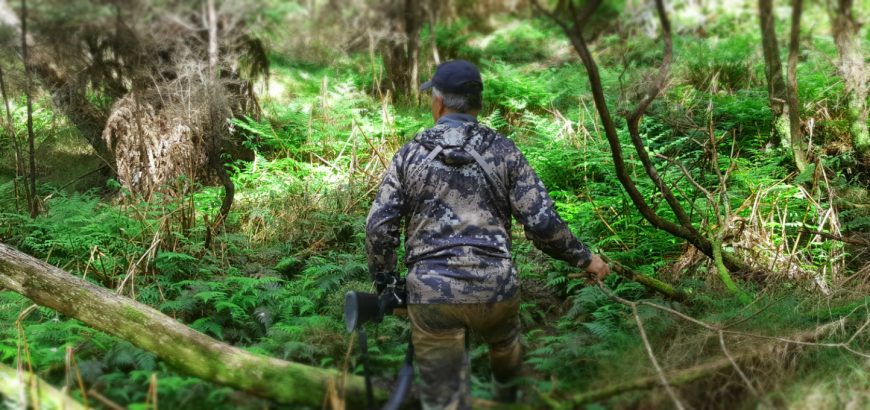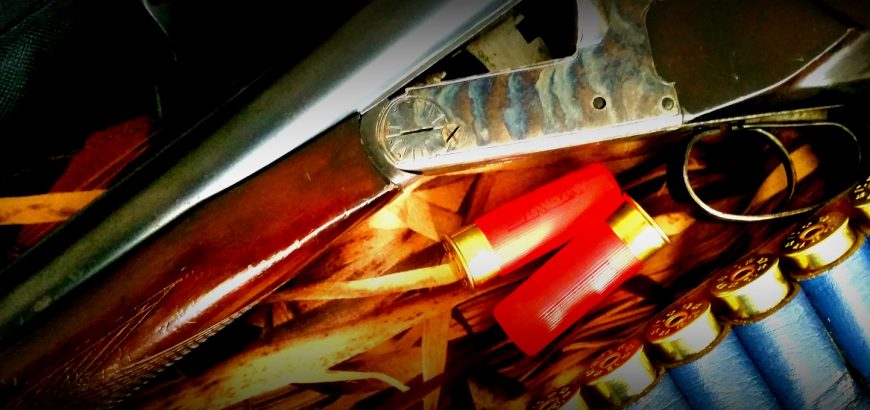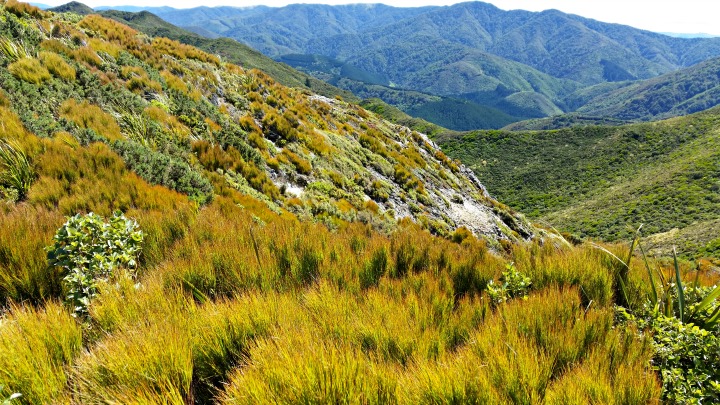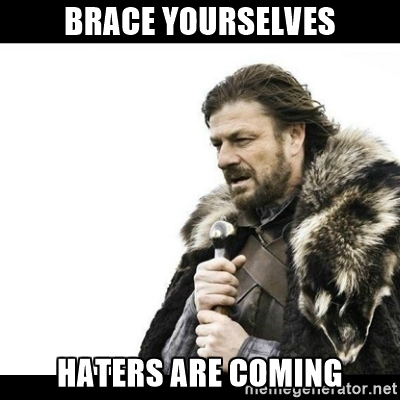I think I need to start this article off by saying my wife is awesome. Not only for all the usual reasons, but also because she’s very understanding of my shooting habit (habit, not hobby – I am addicted). So, for Father’s Day this year my one year old son, with a bit of help from my wife, booked me a hunting trip with Richard from Balnagown Hunting.
Before the start of October rolled around, I was able to get out for a day with Richard, and spend some time on his amazing property, appreciating some great game animals and other wildlife.
I’d already been to Richard’s place, when I attended one of Kerry’s Deer Processing courses, where Richard shared his knowledge on how to gut and skin a deer efficiently. Country Meat Processors were also there, and showed us how to butcher an animal that had been hung for an appropriate length of time (i.e. we didn’t butcher the deer we had just skinned).
Anyway, I digress. I punched the familiar address into my phone and commenced the 1 hour 13 minute drive from my place in Pukekohe, to Balnagown, which is just a bit further than Kaukapakapa.
Richard assured me beforehand that he had everything I needed, so don’t go out buying new stuff if I didn’t have anything on hand. This is great for any new hunters who don’t have the spare cash to get flash camo gear, or who don’t know what they might want to invest in long term.

However, I came fully prepared and met Richard at the Wool Shed, where we compared our Tikka rifles and had a general chat. He took me through his safety and hunting procedures, focusing on when to load up, who will be loaded at what time, and when your finger touches the trigger, as well as reloading immediately after taking your shot. After signing in and enjoying a coffee, we checked each other’s rifles were unloaded and went for a walk.
Richard had been telling me about some previous clients who had spotted a deer 5 minutes into their hunt and wanted to take a shot. Of course Richard told them to hold on, and get a bit more out of the experience than a 5 minute walk into the pines. He reckons they were fishermen, and that a catch in the first 5 mins certainly wouldn’t be thrown back. And I get that, but after putting so much time and effort into preparing for a hunt and a hike through nature, shooting in the first 5 mins and heading home within an hour seems like a waste of an experience to me.
Well, true enough, we bumped into some deer within the first 10 minutes. We came across a couple that Richard spotted with well-trained eyes, and we watched them for a bit before moving on. He pointed out some does and fawns in a paddock as we progressed along the edge of the forest/bush hunting area and rounded our way into a block of pine that Richard planted when he first bought the property.
The well-established trees and dry, brown pine needles provided perfect cover for the fallow deer in between their winter and summer coats. In fact I spotted a buck across the pine block, but he was so well camouflaged that I had to check with Richard if I had seen right, or if my eyes were deceiving me.

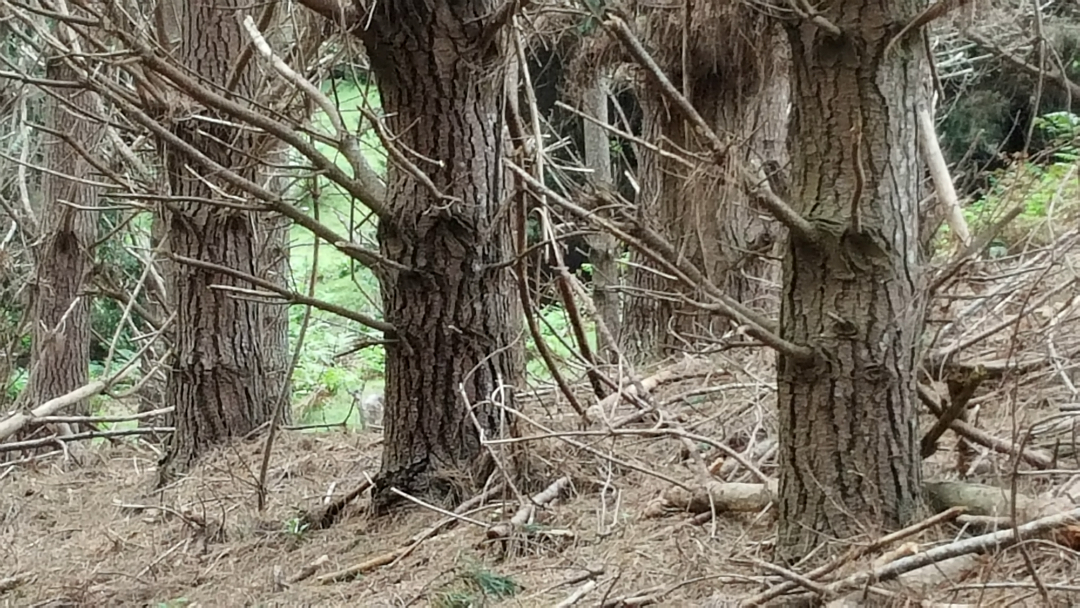
As we exited the pines along a ridge, Richard shared his technique for spotting deer in a valley from behind a ridgeline, without being made out by the deer. Not only the deer down there, but also the animals across the valley on the opposite shoulder, who might see us and bolt, alerting our quarry to our presence.
We could see a few animals here and there across the valley and around the opposite ridge, and we decided to keep going around the edge of the property, through some native bush, and circle back to a purpose-built blind where we could hopefully spot some animals to stalk up on.
We kept low as we transitioned from the pine block over the spine of the hill and into the bush. We spotted some fat wood pigeons and had a chat about possums and rats, when all of a sudden we saw ahead a beautiful doe, on the larger side, standing broadside in the middle of a clearing. We hushed and kept still, observing the animal and seeing if she had spotted us.
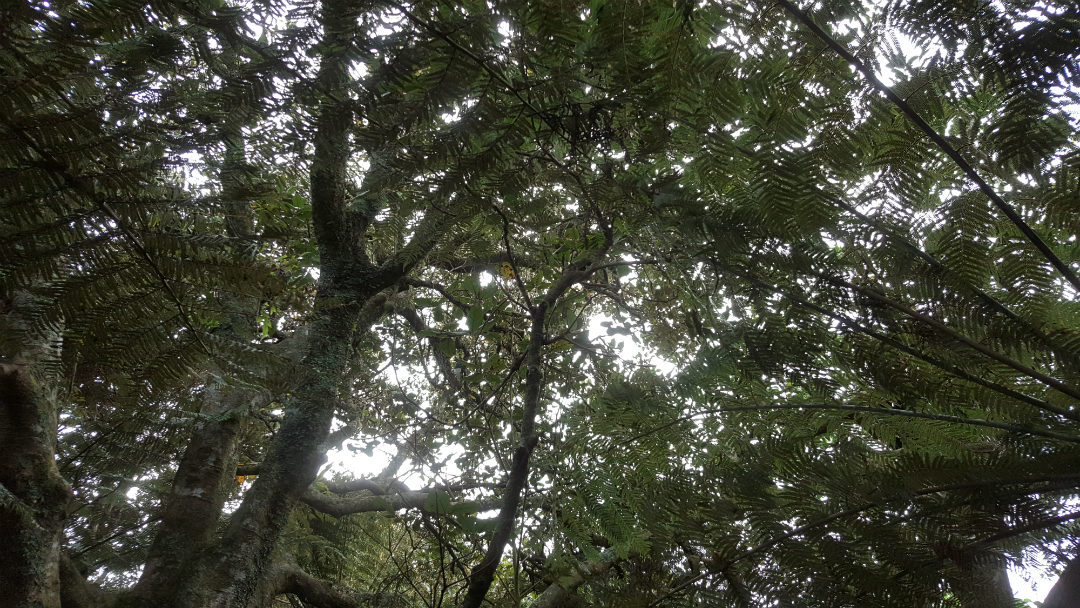
Unaware of our presence, she continued to graze and Richard whispered, “That’s not what we’re after.” We continued to observe for a couple minutes. “Don’t worry,” I eventually replied. “I’m not in a hurry.” I was there for the full experience of Richard’s guidance, and there was still plenty more ground to cover. From what I had seen of Richard in the Deer Processing course, I knew this man had a wealth of knowledge to share. I certainly wasn’t going to get gung ho and pick off an animal an hour in, just to pack up and get home by lunchtime.
We quietly moved off into the bush and made our way south west, keeping our eyes open for sign and animals. After a while we came to a clearing with some very fresh droppings, obviously where some animals had camped the night before. Richard quickly spotted a few deer amongst some dead gorse. I can’t reiterate enough how good his eyes and instincts are. It took me an age to find them, looking off in completely the wrong area. Even when I did find them keeping them in sight amongst the dead, dust-coloured gorse was definitely a challenge.
There was a buck flanked by two spikers, and Richard urged me get my rifle in place and crawl up behind it, while he kept low and spotted for me. The wind was in our favour, gusting gently at around 7 or 10 mph, straight into our faces. There was no way they could smell us.
We waited about 10 or 15 mins for them to move into a clearer patch amongst the gorse and ti trees, when Richard told me to quietly and slowly shift behind another bit of vegetation where I’d have a better shot. Once in position, I realised I had nowhere near enough elevation to make the shot at the deer which were higher than us, unless I want to try an unsupported shot, but there’s no way I could hold that position for 10 or 20 minutes and make a good shot.
I whispered that I was going to shift back a foot or two, so my body was on a better incline behind the rifle. With the bipod at full extension, I now had a good view of the deer. We waited another 10 minutes, sitting silently and stationary, with the wind in our face. Everything was in our favour, with nothing to do but wait for a clean shot.
Then they bolted.
The buck did a quick sidestep and ducked into the bush and out of sight, with the two spikers hot on his heels. Richard laughed. “They’ve got a sixth sense.” He said. And they certainly do. He couldn’t have heard us or seen us, but something didn’t feel right and he decided to get out of there. “That’s why he’s still alive,” Richard said, “Clever buggers…”
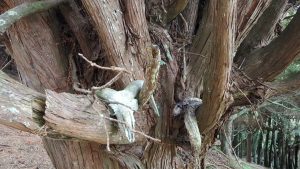
Richard’s admiration for the animals he hunts was clearly evident throughout the day, as he discussed how intelligent and aware they were. His knowledge of their habits was equally impressive.
We picked up our bits and pieces and moved off along the edge of the property to see if we could come across the three males again. We did spot some very fresh sign, but they were gone. And the cheeky sods obviously led us through the gorse. Thankfully not too much of it. We continued through the bush, and pushed through to a large downhill slope, thinly dotted with trees. At the bottom of the hill I could see Richard’s blind.
We meandered our way down and took a seat for a while, glassing the valley to see if there were any animals worth stalking up on. There were a few groups of does and fawns, but no good game animals immediately apparent. We had a bit of a chat and Richard told me about some of his older clients who aren’t up for a long trek through the bush, and how they sat patiently in the blind with coffee and snacks and waited for deer to come into range. Not what you think of when you think of New Zealand hunting, but hey, if I still wanted to get an animal every year when I’m 80 and my legs wouldn’t take me through the bush, maybe I’d do the same.
I was told to take a rest while Richard went off to scout for a few minutes. I pulled out my Vortex Ranger 1500 and spent some time practising estimating distances, and then confirming with the range finder. I won’t say what my strike rate was, but I am improving! I had a bit of water and watched as two swallows decided to play fight around the blind.
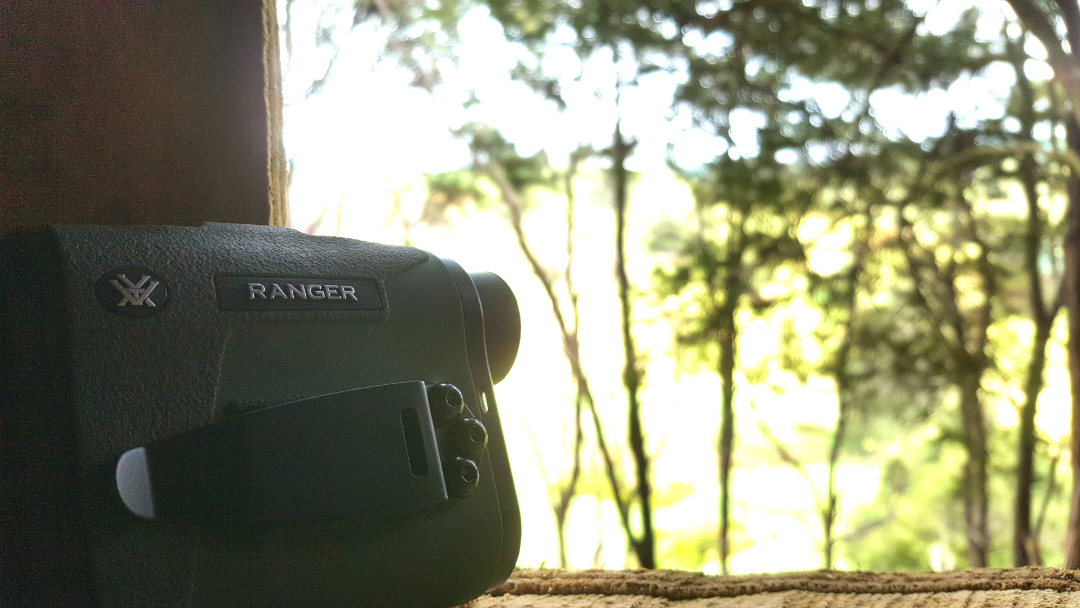
After a while, I began to wonder where my guide had got to. He was quiet, and invisible. Eventually, he came back, but the report wasn’t good. Although he managed to sight a fair few animals across the valley, no groups had any decent spikers, they were mostly concentrations of does and fawns.
So, we made the decision to leave the blind and climb up a ridge to look into the next valley. It was good to get moving again, even if it had only been 20 minutes or so. It wasn’t long before we were out of the trees and covering some open ground uphill to our next position. All the while, a trio of Paradise ducks had decided to fly overhead in a holding pattern, squawking away our position to every creature under the sun. Before long, we had crested the hill, taking care to peek over the top, looking for game.
After a couple furtive glances over the top, we concluded everything on four legs had retired beyond the tree line, and so we moved on a bit before taking a seat and glassing the valley. On the way, Richard showed a patch of fence that had seen better days. “Bucks have been fighting here,” he pointed out.
We sat for a while, looking over at a handful of goats to our left, seeing if a deer or two would give away its position by interacting with them. No such luck. Keeping an eye on the tree line across the valley, we saw a deer come out a couple times in the same spot, but no further activity. We glassed a bit and I played around with the rangefinder, estimating distances to where we saw the deer, the opposite side of the valley, and checking out the goats too. We took a guess at the distance to the goats, and were both surprised it came in at 103 metres.
“Doesn’t seem like a whole rugby field between us and them, does it?” I asked. “That’s just what I was thinking!,” replied Richard. It was interesting to note how the changes in terrain made distances hard to estimate.
We continued to see if there’d be any more activity at the valley floor where we saw the deer before, swapping stories. Richard told me how he had come to acquire his land, and how different it was trying to get a home or a slice of paradise back then, compared to now. Both challenging times, but different challenges. We even ended up talking politics, work, and all sorts of nonsense. The deer didn’t come out again and the goats weren’t being the deer-Judas they might have been.
So we picked up again, and rounded the shoulder of the hill, getting ready to tackle this last stand of native bush before heading in for lunch and trying our luck again. After getting under cover and out of the midday sun, it wasn’t long before our eyes adjusted and a couple young spikers made themselves apparent. Richard confirmed I was loaded and indicated for me to take the lead and begin stalking cover to cover to get a clear shot. As I progressed to cover, trying to keep the trees between myself and the deer, I realised we had walked around into the wind, and it was no longer in our favour. Thankfully it was still for the moment, but any puff of wind would carry our scent right towards our waiting quarry. The wind was the least of our concerns, as the closest spiker saw or heard a bit of movement from my direction and decided to skip along a bit.
They hadn’t seen me yet, but they were aware of my presence, or at least the presence of something that wasn’t there before. The pair went down towards a stream, putting more cover between themselves and my rifle. Over the next ten minutes of tiptoeing through the fallen leaves and branches I spotted them twice more, but only briefly each time, before they got spooked enough to run off where I couldn’t see them or catch up to them.
By this point I had descended about halfway down to the stream, and Richard was waiting a bit higher up towards the tree line. I signalled to him to see if he still had eyes on the two animals, but he shook his head. I wandered up to his position, thrilled from the chase, but annoyed I couldn’t quite close the gap.
We headed towards the bottom of the valley, and Richard gave me some pointers on stalking while we walked down. “Don’t look at the deer,” he said. “You know where they are. Just walk directly to your cover, keeping the tree between you and them – you can re-check their location when you get there.”
We talked a bit as we walked, but mostly in a low whisper. There were plenty of animals in this patch of wood, taking shelter from the heat of the day, browsing amongst the fallen leaves. Some movement ahead revealed the location of a few deer.
Right. On point again.
We weren’t far, maybe 150 metres away when we spotted the group moving around their grazing spot. I went forward, remembering Richard’s advice, moving from cover to cover in a straight line. Richard stayed back with his binos, keeping an eye on the deer. I turned back once I had reached the small group of trees to see if Richard still had the animals in his sight. He had his phone out, taking pictures or a video of me approaching the group. So I took that as a yes. No pressure!
From where I stood, I was definitely close enough to take a shot. I knelt down next to a small tree, holding the forend of the rifle against the trunk with my left hand, creating a rough and ready support. I looked through the Diamondback 4-12×40 scope, and moved the magnification ring up to about 6 power so I could get a clear picture of the deer amongst the dry, brown foliage. I had a quartering shot on a smaller animal, but it didn’t feel great. The deer was moving around slightly as it nosed through the leaves and undergrowth. I didn’t want to take a desperate shot and risk shooting it in the hind quarters if it decided to turn. I knew the 140 gr ELD-M was leaving my 6.5×55 fast enough to shatter the leg and hip bones if struck there, meaning the deer wouldn’t get far and a follow up shot would be needed, but I preferred to make a clean shot that would minimise suffering for the animal, and do less damage to the meat as well.
As I was thinking all this, the deer made up my mind for me and turned to follow a couple old does off to my right. I tracked them in my scope until they came to a stop, but now I had a new problem. The multitude of native trees made for great cover for me, but also got in the way of a clean shot. Time to move.
I headed towards another small group of trees that would keep me from view, but allow me an unobstructed view of the browsing deer. I was almost to my chosen cover when a smaller doe turned around a tree, and looked straight up at me. She stood stock still. Okay, she hadn’t seen me, but she certainly saw or heard my movement. Now I had a decision to make. This young deer obviously hadn’t developed the experience of the older animals, and was still curious enough to try and figure out what was going on, when a deer a couple years older would have done a little jump and buggered off, taking the whole group with them. How much time did I have to take this shot? There was no way to try and take cover and wait for the group to present a better animal. The ponga next to me wasn’t exactly going to hide my 6’2” and 100kg frame.
Standing square on to the animal and with no support in sight, an offhand standing shot was not looking like a great idea, as I would have been way to unstable. Taking the time to move my feet into position and raise the rifle would be all the time the doe needed to make up her mind that she didn’t like the look of me. So, I tried the opposite. I slowly sat back, keeping my upper body as motionless as possible. I felt my water bottle get in the way, and wasn’t sure if I’d get a good seated position with it hanging off the back of my belt. Screw it, I was going to try anyway. I put as much weight on the bottle as possible without making a noise or unbalancing myself. Not bad. I won’t put my water bottle there again, but I was stable enough.
I was still square to the deer, with my feet out in front of me. I slowly lifted the rifle to my cheek and got my elbows settled into the tops of my legs, just behind the knee caps. Feeling pretty stable and good about my position and shot, I took the Tikka off safe with a slight move of my right thumb.
All of this positioning took seconds, even though it felt like I was moving at a glacial pace. I now had a good view. I felt calm and my breathing was good, as I had taken my time to settle into the shot. The young doe continued to look in my direction, but still not quite making me out amongst the low scrub.
Looking through the Vortex scope I could see the deer standing basically broadside to me, on a slight angle, with her head up and looking in my direction. I definitely only had a few seconds to decide on taking this shot or giving away my position and letting the group get away. An older doe walked behind the one I was glassing, and I was tempted to switch targets, given her much larger size, but the small break in the trees that I was aiming through wouldn’t allow me to shift enough to the right. The older doe moved on, heading towards my right, and I continued to check out the smaller animal.
There was a something in the way of my shot, right around the heart and lungs. I backed the scope out to 4 power and got a bit of a better focus, given the short range I’d stalked up to. The brown blob in my way was just a bunch of leaves. That’s fine, I knew where this shot was going, I could see enough of the animal. I focused on my breathing for a second, exhaled and squeezed the trigger on my Tikka.
The sound of the shot sent the rest of the animals running. I counted 6, Richard reckons 7. And I only saw 2 or 3 when stalking in. Damn these animals can camouflage. The doe dropped on the spot, falling backwards into the leaves, exposing her white belly. I watched her, knowing she wasn’t going to move at all, but I remembered to reload again anyway and continued to watch the animal for a few seconds. Richard walked up and congratulated me on the shot, shaking my hand after I had unloaded the rifle and picked up my stray piece of Norma brass (wasn’t going to leave that behind).
I put the magazine and brass in my Hunter’s Element pouch, which sat on my left hip, and pulled out the Vortex Ranger 1500. I placed the illuminated crosshair over the white belly of the doe – 53 metres. No, not a long range shot, the challenge was in stalking up close to the group. I was happy with that. I could only imagine the thrill of the chase for a bow hunter, who gets within feet of his prey. Speaking of which, Richard was talking about opening up a bow only hunting area, but that’s another story.
I walked over from my shooting position, and inspected the animal while Richard took a couple photos for me. As I was walking over I could hear a motor start up and a quad bike heading in our direction. When I got to the deer and inspected the shot placement, I was happy with what I saw. Below the spine and in line with the shoulder, the shot, taken from a higher elevation, had passed through the lung and left a decent sized exit hole on the other side, gushing blood from the wound.
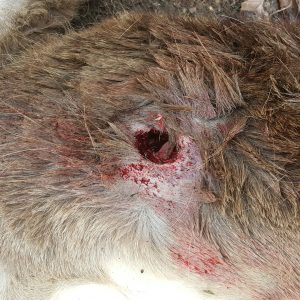
The 6.5mm 140 gr Hornady ELD-M travelling at 2740 fps was probably overkill for this size animal, and a .223 or .243 could easily have done the job, but I was happy with the clean, emphatic kill.
We only had a 100 metres or so to go the edge of the tree line, were Richard expected his son was driving their quad to meet us. We dragged the deer downhill, talking about shot placement and other bits and pieces as we went. I was still buzzing from that stalk.
We got there in a few minutes, and did a final unload and show clear, as Richard’s son pulled up on the quad. He had been preparing lunch when he heard the shot, and decided to come and pick us up. The deer was tied to the front, and we climbed on the back with the rifles, heading towards the hunting hut where we had previously done the meat processing course with Richard, and Kerry from The Bloke.
As we pulled up, there was water on the boil for a cup of coffee, and a good ol’ Kiwi BBQ spread being put on. Our timing couldn’t have been better! I washed the blood off my hands, took off my water bottle and belt bag, and sat down for a hot meal and a coffee with Richard’s family. We discussed the day’s events and other items, and before the others left and Richard and I got to gutting and skinning the deer. It had been a while since I had seen Richard’s pretty awesome technique, so I was glad to get another opportunity to learn this part of his process. If you’re ever looking to learn a bit more or refine your gutting/skinning method, one of the Hunter Education courses is certainly worth the time and money.
We packed the carcass into a vehicle and cleaned off our knives, hands, and the covered deck area where we had hung up the deer. I received a quick tour around the hut and some new “glamping” accommodation Richard was building, overlooking a waterfall and some native bush. From there, we headed back to the main house and my vehicle, my day of hunting complete. Given that I was going to be back in the area in a week, Richard kindly offered to take my deer down to Country Meat Processors in Kaukapakapa for processing into steaks and mince.
Overall, the day was fantastic, and I can see how Balnagown Hunting attracts so many repeat customers. I determined before I left that I’d definitely be back, maybe taking my wife for her first hunt.
